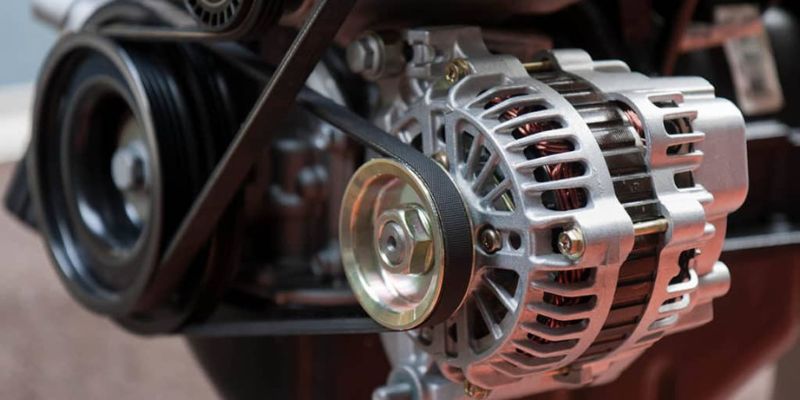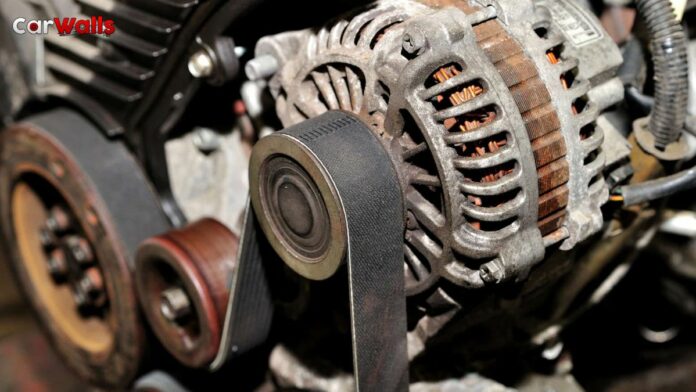Alternator Overcharging Symptoms: A vital component that provides the car with power when the engine is operating is the alternator. The alternator can undercharge, which is a more frequent problem, or overcharge, which can result in a string of electrical failures.
The sole cure for alternator overcharge is to have the alternator reconditioned or replaced. Alternator overcharge is brought on by an incorrect voltage regulator.
How Alternator Works?
The alternator and the battery serve as the engine’s two electric power sources. The battery’s primary function is to supply a powerful burst of electricity to the starter and start the engine. It also has the capacity to power electrical components like the radio and lights when the engine is off.
Alternator Overcharging Symptoms

The battery panel warning light is the first sign of a flawed alternator. To determine and confirm if the alternator is the root of a power problem, use an OBD2 scanner. Without a scanner, you would need to drive your car to a repair and perhaps spend more money than the scanner itself.
The next to go are the headlights and taillights. The lifespan of light bulbs will be severely reduced by variable and high voltage, which will also result in early burnouts. In more severe situations, the excessive voltage will cause the battery to heat up and shorten its lifespan. Additionally frequent are blown fuses and relays, which serve as a safety mechanism to guard against more severe electrical damage.
How To Identify Alternator Overcharge?

The car battery is set to operate at 12.6 volts, while the optimal alternator voltage is 14.2 volts. With these figures and a multimeter, we can easily confirm whether the alternator is overcharging your vehicle.
Step By Step Instructions:
- The multimeter should be set to 20 volts DC.
- The black probe should be connected to the negative battery clamp, and the red probe to the positive.
- The battery’s base reading should be 12.6 volts or at least higher than 12–12.2 volts when the engine is off.
- Start the car. As the alternator begins to recharge the battery, the voltage reading should be between 14.2 and 14.7 volts.
- Turn on the radio, hazards, and headlights. The reading ought to be higher than the voltage of the base battery, ideally over 14 volts.
Frequently Asked Questions
Que 1: Can I Drive With An Overcharging Alternator?
Ans: Driving increases the likelihood of harming electrical parts, particularly lightbulbs and the battery, due to an overcharging alternator. While you don’t have to pull over right away and call a towing company, you also shouldn’t operate your car regularly. Take it to a technician, or fix it yourself using the instructions.
Que 2: Is 15 Volts Too High For An Alternator?
Ans: Although 15 volts is typically seen to be a little too high, it truly depends on what the manufacturer recommends. In order to account for the continual power go caused by the requirement that European cars operate with daytime running lights or standard low beams at all times, the alternator voltage may be increased.
Que 3: Is 18 Volts Too High For An Alternator?
Ans: I can make a point about 15 volts bordering normal operation, but 18 volts is way too high and can overheat the battery. If your alternator is outputting more than 15 volts, it should be replaced or repaired immediately.
Also Read: WHY DOES MY CAR OVERHEATS WHEN AC IS ON?
Conclusion
Although alternator overcharge is a significant issue, it may be resolved in about an hour with the right socket set and a new alternator. Get a quote from the nearby repair groups by giving them a call, or, if it’s more reasonable, invest in a brand-new alternator.
A new alternator requires at least a couple hundred dollars in work, but you can save money by purchasing the necessary tools and keeping them for future repairs. By doing this, you’ll gradually expand your toolkit to the point where practically all fixes only require new parts, drastically lowering the cost of maintenance.


![How Long Can You Drive Without An Oil Cap? [Briefly Explained] How Long Can You Drive Without An Oil Cap?](https://carwalls.org/wp-content/uploads/2023/05/Untitled-design-15-1-218x150.jpg)




